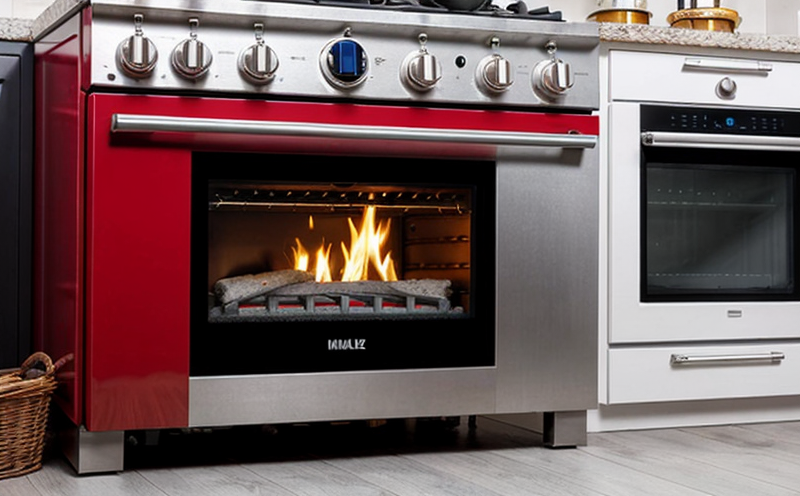UL 1449 Fire Safety Testing of Surge Protective Devices in Appliances
The Underwriters Laboratories (UL) UL 1449 standard is widely recognized for ensuring the safety and performance of surge protective devices (SPDs) used in household appliances. This testing service involves a series of rigorous tests designed to evaluate the fire safety, electrical integrity, and durability of these components.
Surge protective devices are critical components that protect electronic equipment from transient voltage surges caused by lightning strikes or other power disturbances. These devices divert unwanted surge currents away from sensitive electronics, thereby preventing damage. However, in household appliances, the presence of additional materials such as plastics and metals can complicate the testing process.
The UL 1449 test protocol is designed to ensure that SPDs do not contribute to a fire hazard under various stress conditions. The tests are conducted using standardized equipment and methods outlined by UL standards. These tests include evaluating the device's ability to withstand electrical overloads, ensuring it does not become a source of ignition.
During testing, the SPD is subjected to high-voltage surges that simulate real-world conditions. The test apparatus includes a high-voltage generator and a surge protection device under test (SPDUT). The specimen preparation involves mounting the SPD on a standardized test fixture. Once mounted, the specimen undergoes several cycles of overvoltage application to assess its performance.
The UL 1449 standard specifies acceptance criteria that must be met for the device to pass the tests. These criteria include limits on the amount of heat generated during the surge events and ensuring that no sparks or arcs are produced. The testing also evaluates the SPD's ability to maintain its protective function without failing or causing a fire hazard.
The importance of this test cannot be overstated, especially in household appliances where the presence of combustible materials can exacerbate potential hazards. By adhering to UL 1449 standards, manufacturers ensure that their surge protective devices contribute positively to the overall safety and reliability of their products.
- Ensures compliance with international standards for fire safety
- Reduces risks associated with electrical surges in household appliances
- Promotes trust among consumers regarding product safety
- Facilitates market access to regions that require UL certification
Why It Matters
The fire safety of surge protective devices is paramount, especially in household appliances where the presence of combustible materials can lead to severe consequences. By adhering to the UL 1449 standard, manufacturers ensure that their products meet strict fire safety requirements.
The importance of this test extends beyond compliance with regulations; it also contributes to the overall reliability and durability of household appliances. Surge protective devices play a crucial role in protecting sensitive electronic components from damage caused by electrical surges. By ensuring these devices do not themselves become sources of ignition, UL 1449 testing helps prevent fires that could result from improper SPD function.
Consumer trust is another significant factor influenced by rigorous fire safety testing. When consumers know that their appliances meet stringent safety standards like those outlined in UL 1449, they are more likely to choose products from reputable manufacturers. This not only enhances brand reputation but also fosters confidence among end users.
In summary, the UL 1449 fire safety testing of surge protective devices is crucial for ensuring product safety, reducing potential risks associated with electrical surges in household appliances, and maintaining consumer trust.
Industry Applications
The application of UL 1449 fire safety testing extends across various industries where surge protective devices are used. In the context of household appliances, this standard is particularly relevant for manufacturers of refrigerators, washing machines, dishwashers, and other electronics integrated into these devices.
Refrigerators, for instance, often contain sensitive electronic components that require protection against power surges to ensure longevity and efficiency. Similarly, washing machines may have control systems vulnerable to electrical disruptions, necessitating robust SPDs to safeguard them.
Dishwashers also benefit from surge protective devices due to their complex electronic circuits controlling the operation of various functions like water pumps and heating elements. By implementing UL 1449 compliant SPDs, these appliances can operate more reliably while reducing the risk of electrical failures that could potentially lead to fires.
In summary, industries involved in manufacturing household appliances should prioritize UL 1449 fire safety testing to ensure their products meet stringent safety standards and contribute positively to public welfare.
Why Choose This Test
- Ensures compliance with international standards for fire safety
- Promotes consumer trust through rigorous testing protocols
- Reduces risks associated with electrical surges in household appliances
- Facilitates market access to regions that require UL certification
- Aid in the development of safer and more reliable products
- Guarantees durability and longevity of SPDs under harsh conditions
- Reduces liability risks for manufacturers
- Supports continuous improvement through detailed test reports





